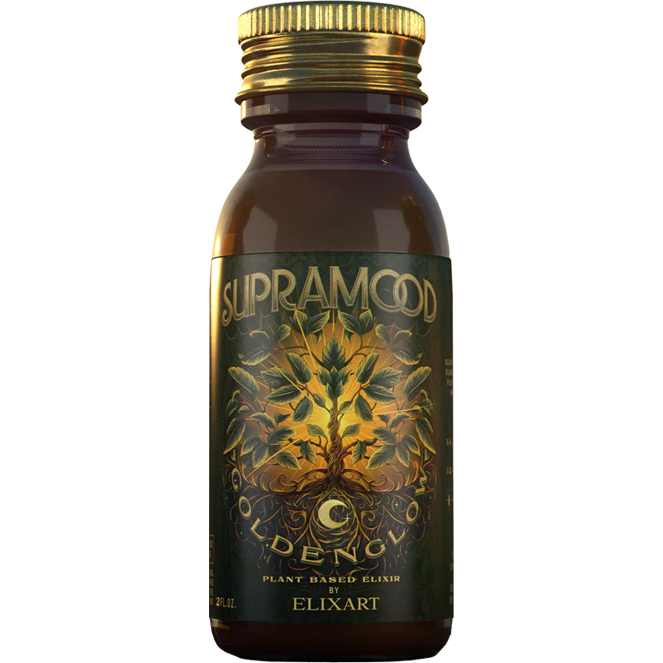Introduction
The leaves of the kratom tree (Mitragyna speciosa, Rubiaceae family) have been consumed for centuries in Southeast Asia. Traditionally, kratom has been used to manage pain and alleviate symptoms related to various ailments.
In recent years, there has been a growing interest in kratom as a modern pain relief strategy. Its potential analgesic properties have garnered significant attention among individuals seeking alternative treatments for chronic pain and opioid withdrawal symptoms. This has led to the emergence of products like the Goldenglow Elixir, an herbal drink that combines kratom with other powerful plants such as Kava, Passion Fruit, Coconut, Turmeric, and Ginger. These ingredients are known to naturally stimulate focus and presence while providing potential relief.
Kratom is a controversial herbal remedy that has gained popularity for its potential benefits in pain management. Despite anecdotal evidence supporting its use, more research is essential to fully understand its efficacy and safety profile.
Understanding Kratom and Its Mechanism of Action
Description and Origins of Kratom
Kratom (Mitragyna speciosa) is a tropical evergreen tree native to Southeast Asia, specifically in countries like Thailand, Indonesia, Malaysia, and Papua New Guinea. As a member of the Rubiaceae family, which also includes coffee plants, kratom has been traditionally used for centuries due to its psychoactive properties. The leaves of the kratom tree have played a significant role in traditional medicine practices in these regions.
Active Compounds in Kratom
The primary active compounds in kratom are mitragynine and 7-hydroxymitragynine. These alkaloids are principally responsible for kratom's effects.
- Mitragynine: The most abundant alkaloid in kratom, mitragynine is known for its analgesic properties. It interacts with opioid receptors in the brain, particularly the mu-opioid receptors, which play a crucial role in pain perception.
- 7-Hydroxymitragynine: Although present in smaller quantities compared to mitragynine, 7-hydroxymitragynine is significantly more potent as an analgesic. This compound also targets the mu-opioid receptors but does so with greater efficacy, contributing to kratom's pain-relieving effects.
Interaction with Opioid Receptors
Both mitragynine and 7-hydroxymitragynine interact with opioid receptors in the brain, similar to how traditional opioids work. By binding to these receptors:
- They help reduce the perception of pain.
- They can induce feelings of euphoria and relaxation.
- They may impact mood and anxiety levels.
However, unlike typical opioids, these compounds may produce fewer respiratory depressant effects, potentially offering a safer profile for managing pain according to recent studies on kratom's safety and efficacy.
Historical Uses in Traditional Medicine
In traditional medicine across Southeast Asia:
- Pain Relief: Kratom has been commonly used by laborers and farmers to alleviate pain and fatigue from long working hours.
- Energy Boost: Small doses were often consumed as a stimulant to increase energy levels and combat tiredness.
- Opioid Withdrawal: Historically, kratom has been utilized as a remedy to manage withdrawal symptoms from opium dependence.
Understanding kratom involves recognizing its origins, active compounds, and traditional uses. Mitragyna speciosa’s primary alkaloids—mitragynine and 7-hydroxymitragynine—interact with opioid receptors to deliver potential analgesic benefits. Historical applications underscore its longstanding role in traditional medicine for various ailments.
Methods of Consuming Kratom for Pain Relief
Different Forms of Kratom Available
Kratom is available in various forms, each with distinct characteristics affecting its bioavailability and onset time for pain relief:
- Powder: The most common form, made by grinding dried kratom leaves. It can be mixed with liquids or food, offering quick absorption but often has a bitter taste.
- Capsules: Encapsulated kratom powder provides a convenient and tasteless option. However, the onset time might be slower due to the time required for the capsule to dissolve.
- Tea: Brewing kratom leaves into tea is a traditional method. The liquid form allows for faster absorption, though the preparation can be time-consuming and the taste can be quite bitter.
- Extracts: Concentrated forms of kratom that are more potent and provide quicker relief. They come in liquid or resin form but are typically more expensive.
Traditional Preparation Methods
Traditional use of kratom often involves preparing a decoction. This method includes boiling the leaves to extract active compounds:
- Boiling: Dried or fresh kratom leaves are boiled in water for an extended period.
- Straining: The liquid is strained to remove leaf particles, resulting in a concentrated tea.
Advantages of Decoction
- Potency: Boiling enhances the extraction of active compounds like mitragynine and 7-hydroxymitragynine.
- Rapid Absorption: Liquid forms are absorbed faster by the body compared to powders or capsules.
Disadvantages of Decoction
- Preparation Time: The process can be lengthy and requires attention.
- Taste: The resulting tea is often very bitter, which can be off-putting to some users.
Exploring these methods helps individuals choose the most suitable form based on their needs and preferences regarding convenience, taste, and onset time for pain relief.
Clinical Studies on Kratom's Effectiveness for Pain Management
While the traditional use of kratom for pain relief has been well-documented, clinical studies evaluating its effectiveness are limited. The majority of existing research consists of observational studies and surveys rather than rigorously controlled trials. Key findings from these studies include:
1. Observational Studies
- A large-scale survey conducted by Grundmann (2017) with over 8,000 participants found that a significant portion of kratom users reported using the herb primarily for pain relief.
- Another survey by Swogger et al. (2015) highlighted that users often found kratom effective in managing chronic pain conditions, including arthritis and fibromyalgia.
2. Case Reports
Several case reports have documented individuals using kratom to manage pain successfully. However, these reports lack the scientific rigor required to draw definitive conclusions about its efficacy.
Despite promising anecdotal and observational evidence, there's a pressing need for more rigorous clinical trials to establish a clear safety and efficacy profile for kratom in pain management:
1. Randomized Controlled Trials (RCTs)
An RCT is considered the gold standard in clinical research. To date, no large-scale RCTs have evaluated kratom's effectiveness specifically for pain relief.
2. Placebo-Controlled Studies
Placebo-controlled studies are essential to eliminate bias and determine whether kratom’s effects are due to its pharmacological action or a placebo effect. Existing studies often lack this critical component.
3. Safety Profile
Comprehensive trials are also needed to assess the long-term safety of kratom use. Current data on side effects like nausea, dizziness, and dependence is primarily derived from user reports rather than structured clinical observation.
While existing research provides some support for kratom’s potential in pain management, the absence of robust clinical trials leaves many questions unanswered. Establishing a reliable safety and efficacy profile through randomized controlled and placebo-controlled studies is crucial for integrating kratom into modern pain management strategies effectively.
Moreover, emerging studies also suggest that kratom could have potential benefits beyond just pain management, indicating a wider scope of therapeutic applications that warrant further investigation. Nonetheless, it's important to approach these findings with caution until more comprehensive research is conducted.
Self-reported Effects, Anecdotal Evidence, and Safety Profile of Kratom Usage
Anecdotal Evidence: Effectiveness for Pain Management and Opioid Withdrawal
Many people have turned to kratom as a potential alternative for managing pain and alleviating opioid withdrawal symptoms. Self-reported effects of kratom often highlight its ability to relieve pain, with users claiming significant relief from chronic pain conditions. These anecdotal reports suggest that kratom may offer a solution for those seeking non-prescription alternatives to conventional pain medications.
Effectiveness for Pain Management:
- Users often describe kratom's ability to manage pain similar to that of opioids but with fewer adverse effects.
- Testimonials frequently cite the use of kratom for conditions like arthritis, fibromyalgia, and back pain.
- Many individuals report using kratom to mitigate withdrawal symptoms associated with opioid dependency.
- Commonly mentioned benefits include a reduction in cravings, improvement in mood, and alleviation of physical discomfort.
The reliability and validity of these self-reported effects remain subjects of debate. While such testimonials provide valuable insights into individual experiences, they lack the rigor of controlled clinical studies. As a result, the scientific community emphasizes the need for more systematic research to substantiate these claims.
Safety Profile: Potential Side Effects
Despite its perceived benefits, the safety profile of kratom has raised concerns among healthcare professionals and regulatory agencies. Users have reported various side effects that range from mild to severe.
Common Side Effects:
- Nausea: Frequently noted by users, especially at higher doses.
- Constipation: Reported by many as a recurring issue during prolonged use.
- Dizziness: Can occur shortly after consumption and may affect daily activities.
Serious Concerns:
- There have been reports linking kratom use to hepatotoxicity (liver damage) and nephrotoxicity (kidney damage).
- Cases of severe withdrawal symptoms upon cessation suggest potential addictive properties.
Evaluating Anecdotal Evidence
Given the wide array of self-reported effects, evaluating the safety profile of kratom involves considering both positive testimonials and adverse experiences.
"While anecdotal evidence provides a wealth of information on user experiences, it is essential to approach such data critically due to its subjective nature."
The intersection between anecdotal evidence and scientific validation is crucial. Although user reports offer preliminary insights into kratom’s utility for pain management and opioid withdrawal, rigorous clinical trials are necessary to establish a definitive safety and efficacy profile.
Long-term Use, Dependence Issues, Legal Status, and Regulatory Considerations Surrounding Kratom Consumption for Pain Management
Potential Risks Associated with Long-term Use
Long-term kratom use effects are a significant concern within the medical community. Chronic consumption of kratom has been linked to several potential health issues:
- Liver Toxicity: Reports have indicated that prolonged use may lead to hepatotoxicity, causing liver damage.
- Gastrointestinal Issues: Regular users often experience digestive problems, including constipation and nausea.
- Cardiovascular Problems: There is evidence suggesting that long-term usage might affect cardiovascular health, potentially leading to elevated heart rate and hypertension.
Addictive Properties of Kratom
Kratom's addictive properties are another contentious topic. The primary active compounds, mitragynine and 7-hydroxymitragynine, interact with opioid receptors in the brain, which can lead to dependence. Symptoms of kratom dependence may include:
- Tolerance: Users may require increasing amounts to achieve the same pain-relief effects.
- Withdrawal Symptoms: These can be similar to those experienced during opioid withdrawal and may include irritability, muscle aches, insomnia, and mood swings.
Legal Status of Kratom in Different Regions
The legal status of kratom varies significantly across the globe:
- United States: The FDA has not approved kratom for any medical use, and it remains unregulated at the federal level. However, several states have either banned or restricted its sale and use.
- Europe: Countries like Denmark, Finland, Poland, Lithuania, Latvia, Romania, and Sweden have banned kratom. In contrast, it remains legal in other parts of Europe under certain restrictions.
- Asia: Thailand has legalized kratom for medical purposes as part of traditional medicine practices. Other countries like Malaysia and Myanmar have stringent prohibitions against its use.
Regulatory Considerations by Agencies Like FDA
Regulatory agencies grapple with the classification of kratom due to its complex profile:
- FDA Stance: The FDA has issued multiple warnings about the potential dangers of kratom consumption. There have been attempts to classify it as a Schedule I substance under the Controlled Substances Act (CSA), which would place it alongside drugs like heroin and LSD.
- Scientific Community: Researchers advocate for more rigorous studies to establish a comprehensive safety profile before making definitive regulatory decisions.
The debate continues as regulatory bodies weigh potential therapeutic benefits against risks such as addiction and toxicity. This ongoing scrutiny underscores the importance of consulting healthcare professionals before considering kratom as a pain management option.
Making an Informed Decision: Consulting Healthcare Professionals Before Using Kratom for Pain Management
Consulting healthcare professionals before using kratom as a treatment option is crucial. This step ensures that individuals make informed decisions based on a comprehensive understanding of their health conditions and possible interactions with other medications.
Weighing the benefits against potential risks is essential, given the current knowledge and ongoing debates surrounding kratom. Healthcare professionals can provide personalized advice, considering factors such as:
- Medical history: Pre-existing conditions may influence how one reacts to kratom.
- Medication interactions: Some compounds in kratom might interact negatively with prescription drugs.
- Individual response: Not everyone responds to herbal treatments similarly.
While kratom has gained popularity for its potential analgesic properties, it carries risks that should not be overlooked. Engaging with a healthcare provider helps users navigate these complexities, maximizing benefits while minimizing adverse effects.
Key takeaway: Always consult healthcare professionals to ensure safe and effective use of kratom for pain management. Balancing the benefits vs. risks is vital in making an informed decision regarding this controversial herbal remedy.
FAQs (Frequently Asked Questions)
What is kratom and how has it been historically used?
Kratom, or Mitragyna speciosa, is a plant from the Rubiaceae family that has been traditionally used in Southeast Asia for various ailments, including pain management. Its historical use highlights its importance as a potential herbal remedy, although it is considered controversial in modern contexts.
How do the active compounds in kratom work for pain relief?
The primary active compounds in kratom are mitragynine and 7-hydroxymitragynine. These compounds interact with opioid receptors in the brain, which may contribute to their analgesic properties. However, more research is needed to fully understand their mechanism of action.
What are the different methods of consuming kratom for pain relief?
Kratom can be consumed in various forms, including powder, capsules, tea, and extracts. Each method has its own bioavailability and onset time for pain relief. Traditional preparation methods such as decoction are also common but may vary in convenience and taste.
What does current research say about kratom's effectiveness for pain management?
Key clinical studies have evaluated kratom's effectiveness for pain relief; however, there is a consensus on the need for more rigorous clinical trials to establish its safety and efficacy profile. The existing studies often lack sufficient rigor and control.
What are the safety concerns associated with kratom usage?
Users have reported various side effects from kratom use, including nausea, constipation, and dizziness. While anecdotal evidence suggests its effectiveness for pain management and opioid withdrawal symptoms, the reliability of self-reported effects raises safety concerns.
What should I consider before using kratom for pain management?
It is crucial to consult healthcare professionals before using kratom as a treatment option. Weighing the benefits against potential risks based on current knowledge can help make an informed decision regarding its use, especially considering issues related to long-term dependence and legal status.








Leave a comment
This site is protected by reCAPTCHA and the Google Privacy Policy and Terms of Service apply.